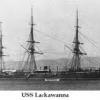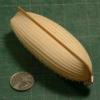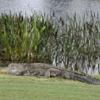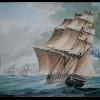-
Posts
3,084 -
Joined
-
Last visited
Reputation Activity
-
 Jaager got a reaction from thibaultron in Painting White/Pot Metal.
Jaager got a reaction from thibaultron in Painting White/Pot Metal.
John,
It looks like I completely missed what you were asking. It did not occur to me that you wished to paint a metal casting to look like it was raw wood. The only practical reason for a figurehead on a model to be raw wood at all, is if the builder had actually carved it from a block of wood - and wished to show that off. As others have pointed out, in your situation pigmented covering layers should be used. The other factors - water based paint vs oil based paint - bright and garish vs subtle, subdued, and scale sensitive - is a matter of personal taste and you are the final arbiter of that.
To be glib, I think the only way to get a convincing raw wood figurehead is to start with a block of wood and carve it yourself, using the casting as a guide. For this sort of part, there is a wide number of choices for wood, since among other sources pen turning stock can be used. That stuff has a high cost per BF, but fraction of a BF is small.
-
 Jaager got a reaction from Canute in Painting White/Pot Metal.
Jaager got a reaction from Canute in Painting White/Pot Metal.
John,
It looks like I completely missed what you were asking. It did not occur to me that you wished to paint a metal casting to look like it was raw wood. The only practical reason for a figurehead on a model to be raw wood at all, is if the builder had actually carved it from a block of wood - and wished to show that off. As others have pointed out, in your situation pigmented covering layers should be used. The other factors - water based paint vs oil based paint - bright and garish vs subtle, subdued, and scale sensitive - is a matter of personal taste and you are the final arbiter of that.
To be glib, I think the only way to get a convincing raw wood figurehead is to start with a block of wood and carve it yourself, using the casting as a guide. For this sort of part, there is a wide number of choices for wood, since among other sources pen turning stock can be used. That stuff has a high cost per BF, but fraction of a BF is small.
-
 Jaager got a reaction from mtaylor in A Formular for wind pressure and other sailing related calculations
Jaager got a reaction from mtaylor in A Formular for wind pressure and other sailing related calculations
Would not the core calculation be: F = mVV?
The surface area that the force acted on would be an absolute bear to determine. It would also probably be dynamic, with the effective sail area adapting and changing with differences in force. I can imagine that the complexity exceeds any practical utility for a formula in predicting a wind speed vs vessel speed. Reverse calculations should work. Measure the two speeds and the necessary force can be cranked out.
One factor that I keep overlooking is that a slight incremental change in wind speed can have a significant effect on vessel speed. Why the frantic and continuous changes in sail area and sail angle was necessary when wind speed was above a critical value. And also why a sudden and unfortunate change in wind direction could roll a vessel with a poor design past the point where it could right itself.
-
 Jaager got a reaction from mtaylor in QQ Gunports and planking - 1719 Establishment period. Questions:
Jaager got a reaction from mtaylor in QQ Gunports and planking - 1719 Establishment period. Questions:
I am still uncertain as to the way to construct the visible part of the gun ports.
That is a ways off.
I am taking a break because I can find no simple way to remove the Scotch Tape adhesive from the frame openings so that I can shellac them. It resists Naphtha, Lacquer thinner, Heptane, EtOH, IsopOH, but Mineral Spirits seemed to do more than the others on a quick test. I know now that I should have only burnished the tape on the Pine filler and not the Maple frames. Now needs to return inspiration and determination - before I am seduced by another hull to frame..
-
 Jaager got a reaction from druxey in QQ Gunports and planking - 1719 Establishment period. Questions:
Jaager got a reaction from druxey in QQ Gunports and planking - 1719 Establishment period. Questions:
I am still uncertain as to the way to construct the visible part of the gun ports.
That is a ways off.
I am taking a break because I can find no simple way to remove the Scotch Tape adhesive from the frame openings so that I can shellac them. It resists Naphtha, Lacquer thinner, Heptane, EtOH, IsopOH, but Mineral Spirits seemed to do more than the others on a quick test. I know now that I should have only burnished the tape on the Pine filler and not the Maple frames. Now needs to return inspiration and determination - before I am seduced by another hull to frame..
-
 Jaager got a reaction from allanyed in A Formular for wind pressure and other sailing related calculations
Jaager got a reaction from allanyed in A Formular for wind pressure and other sailing related calculations
Would not the core calculation be: F = mVV?
The surface area that the force acted on would be an absolute bear to determine. It would also probably be dynamic, with the effective sail area adapting and changing with differences in force. I can imagine that the complexity exceeds any practical utility for a formula in predicting a wind speed vs vessel speed. Reverse calculations should work. Measure the two speeds and the necessary force can be cranked out.
One factor that I keep overlooking is that a slight incremental change in wind speed can have a significant effect on vessel speed. Why the frantic and continuous changes in sail area and sail angle was necessary when wind speed was above a critical value. And also why a sudden and unfortunate change in wind direction could roll a vessel with a poor design past the point where it could right itself.
-
 Jaager got a reaction from DaKea90 in A Formular for wind pressure and other sailing related calculations
Jaager got a reaction from DaKea90 in A Formular for wind pressure and other sailing related calculations
Would not the core calculation be: F = mVV?
The surface area that the force acted on would be an absolute bear to determine. It would also probably be dynamic, with the effective sail area adapting and changing with differences in force. I can imagine that the complexity exceeds any practical utility for a formula in predicting a wind speed vs vessel speed. Reverse calculations should work. Measure the two speeds and the necessary force can be cranked out.
One factor that I keep overlooking is that a slight incremental change in wind speed can have a significant effect on vessel speed. Why the frantic and continuous changes in sail area and sail angle was necessary when wind speed was above a critical value. And also why a sudden and unfortunate change in wind direction could roll a vessel with a poor design past the point where it could right itself.
-
 Jaager got a reaction from Canute in Thickness sander
Jaager got a reaction from Canute in Thickness sander
There is always the option to build your own.
Were you in the US, I would say that this option would probably not be less expensive than a Byrnes sander when all factors are summed.
The key factors:
Go quality.
Use a large enough motor. 1/3 HP is the sweet spot. 1/2 HP tends to be heavy and bulky.
A reversible motor is NOT needed. Unless you also want it to be a medieval siege engine.
DO NOT enclose the motor! Sanding is a lot of work for a motor. Work = heat. As much air flow as possible!
The drum holding the sanding medium needs to have a large enough diameter - somewhere around 3 inches - before the medium was available as continuous cloth backed rolls, the width of commercial sanding sheets set the diameter.
added: The drum speed should be ~1700 rpm - faster and the wood burns - slower is slower -
that is a common speed for 1/3 HP motors and 1:1 on pulleys is easy.
Having a mechanical grip on the roll is way more convenient than using an adhesive to hold the medium.
A dead flat table that stays that way is absolutely necessary.
A reliable and micro adjustable gap set and hold mechanism is a must.
A dust extraction hood is absolutely needed, but no big deal. I made mine using three layers of Amazon box cardboard, liberal PVA between the layers, 1/4" square internal corner braces, and duct tape.
A kludge sander will sort of work for a time, but will ultimately be a source of frustration.
-
 Jaager got a reaction from EricWilliamMarshall in Thickness sander
Jaager got a reaction from EricWilliamMarshall in Thickness sander
There is always the option to build your own.
Were you in the US, I would say that this option would probably not be less expensive than a Byrnes sander when all factors are summed.
The key factors:
Go quality.
Use a large enough motor. 1/3 HP is the sweet spot. 1/2 HP tends to be heavy and bulky.
A reversible motor is NOT needed. Unless you also want it to be a medieval siege engine.
DO NOT enclose the motor! Sanding is a lot of work for a motor. Work = heat. As much air flow as possible!
The drum holding the sanding medium needs to have a large enough diameter - somewhere around 3 inches - before the medium was available as continuous cloth backed rolls, the width of commercial sanding sheets set the diameter.
added: The drum speed should be ~1700 rpm - faster and the wood burns - slower is slower -
that is a common speed for 1/3 HP motors and 1:1 on pulleys is easy.
Having a mechanical grip on the roll is way more convenient than using an adhesive to hold the medium.
A dead flat table that stays that way is absolutely necessary.
A reliable and micro adjustable gap set and hold mechanism is a must.
A dust extraction hood is absolutely needed, but no big deal. I made mine using three layers of Amazon box cardboard, liberal PVA between the layers, 1/4" square internal corner braces, and duct tape.
A kludge sander will sort of work for a time, but will ultimately be a source of frustration.
-
 Jaager got a reaction from mtaylor in Thickness sander
Jaager got a reaction from mtaylor in Thickness sander
There is always the option to build your own.
Were you in the US, I would say that this option would probably not be less expensive than a Byrnes sander when all factors are summed.
The key factors:
Go quality.
Use a large enough motor. 1/3 HP is the sweet spot. 1/2 HP tends to be heavy and bulky.
A reversible motor is NOT needed. Unless you also want it to be a medieval siege engine.
DO NOT enclose the motor! Sanding is a lot of work for a motor. Work = heat. As much air flow as possible!
The drum holding the sanding medium needs to have a large enough diameter - somewhere around 3 inches - before the medium was available as continuous cloth backed rolls, the width of commercial sanding sheets set the diameter.
added: The drum speed should be ~1700 rpm - faster and the wood burns - slower is slower -
that is a common speed for 1/3 HP motors and 1:1 on pulleys is easy.
Having a mechanical grip on the roll is way more convenient than using an adhesive to hold the medium.
A dead flat table that stays that way is absolutely necessary.
A reliable and micro adjustable gap set and hold mechanism is a must.
A dust extraction hood is absolutely needed, but no big deal. I made mine using three layers of Amazon box cardboard, liberal PVA between the layers, 1/4" square internal corner braces, and duct tape.
A kludge sander will sort of work for a time, but will ultimately be a source of frustration.
-
 Jaager got a reaction from Obormotov in Harold Hahn method
Jaager got a reaction from Obormotov in Harold Hahn method
As far as RN framing is concerned, you could always "eat the mushrooms!" and use one of many stylized framing alternatives. To my eye the actual RN framing has almost zero artistic merit. It was purely functional, based on necessity, was not intended to be seen and looks it.
The French and North Americans tended to frame using all bends and a minimal number of cant frames if any.
Be very careful with Hermoine. Especially if you use the individual bend/frame patterns in the monograph. The author of that monograph often folds in problems in his lines and lofting work. Fixed with a little or a lot of work - depending on the ship - Hermoine = minor St. Philippe = major. There are more attractive French frigates in the ANCRE inventory.
-
 Jaager got a reaction from Tim Holt in Thickness sander
Jaager got a reaction from Tim Holt in Thickness sander
There is always the option to build your own.
Were you in the US, I would say that this option would probably not be less expensive than a Byrnes sander when all factors are summed.
The key factors:
Go quality.
Use a large enough motor. 1/3 HP is the sweet spot. 1/2 HP tends to be heavy and bulky.
A reversible motor is NOT needed. Unless you also want it to be a medieval siege engine.
DO NOT enclose the motor! Sanding is a lot of work for a motor. Work = heat. As much air flow as possible!
The drum holding the sanding medium needs to have a large enough diameter - somewhere around 3 inches - before the medium was available as continuous cloth backed rolls, the width of commercial sanding sheets set the diameter.
added: The drum speed should be ~1700 rpm - faster and the wood burns - slower is slower -
that is a common speed for 1/3 HP motors and 1:1 on pulleys is easy.
Having a mechanical grip on the roll is way more convenient than using an adhesive to hold the medium.
A dead flat table that stays that way is absolutely necessary.
A reliable and micro adjustable gap set and hold mechanism is a must.
A dust extraction hood is absolutely needed, but no big deal. I made mine using three layers of Amazon box cardboard, liberal PVA between the layers, 1/4" square internal corner braces, and duct tape.
A kludge sander will sort of work for a time, but will ultimately be a source of frustration.
-
 Jaager got a reaction from mtaylor in Painting White/Pot Metal.
Jaager got a reaction from mtaylor in Painting White/Pot Metal.
I may well be totally wrong here, but:
Acrylics have looked to me like they have a sandy/dusty, pastel look to them.
Oil based paint seems to be more crisp with a more pure color look.
"fat over lean" means that oils can be used over the primer that you have.
I am not sure just how color alone can change a casting into a wood carving.
I wonder if the difference is that a casting is more rounded and smoother where two planes meet.
Perhaps actual carving with very sharp chisels done very lightly will produce a more angular look?
You would have to touch up the primer and the oil can be a bit transparent - and - for scale effect not at all glossy - a flatting agent. Last month, Amazon was $10-15 less expensive than West Marine for their own flattening product.
-
 Jaager got a reaction from JohnB40 in Painting White/Pot Metal.
Jaager got a reaction from JohnB40 in Painting White/Pot Metal.
I may well be totally wrong here, but:
Acrylics have looked to me like they have a sandy/dusty, pastel look to them.
Oil based paint seems to be more crisp with a more pure color look.
"fat over lean" means that oils can be used over the primer that you have.
I am not sure just how color alone can change a casting into a wood carving.
I wonder if the difference is that a casting is more rounded and smoother where two planes meet.
Perhaps actual carving with very sharp chisels done very lightly will produce a more angular look?
You would have to touch up the primer and the oil can be a bit transparent - and - for scale effect not at all glossy - a flatting agent. Last month, Amazon was $10-15 less expensive than West Marine for their own flattening product.
-
 Jaager got a reaction from Canute in Painting White/Pot Metal.
Jaager got a reaction from Canute in Painting White/Pot Metal.
I may well be totally wrong here, but:
Acrylics have looked to me like they have a sandy/dusty, pastel look to them.
Oil based paint seems to be more crisp with a more pure color look.
"fat over lean" means that oils can be used over the primer that you have.
I am not sure just how color alone can change a casting into a wood carving.
I wonder if the difference is that a casting is more rounded and smoother where two planes meet.
Perhaps actual carving with very sharp chisels done very lightly will produce a more angular look?
You would have to touch up the primer and the oil can be a bit transparent - and - for scale effect not at all glossy - a flatting agent. Last month, Amazon was $10-15 less expensive than West Marine for their own flattening product.
-
 Jaager got a reaction from thibaultron in Painting White/Pot Metal.
Jaager got a reaction from thibaultron in Painting White/Pot Metal.
I may well be totally wrong here, but:
Acrylics have looked to me like they have a sandy/dusty, pastel look to them.
Oil based paint seems to be more crisp with a more pure color look.
"fat over lean" means that oils can be used over the primer that you have.
I am not sure just how color alone can change a casting into a wood carving.
I wonder if the difference is that a casting is more rounded and smoother where two planes meet.
Perhaps actual carving with very sharp chisels done very lightly will produce a more angular look?
You would have to touch up the primer and the oil can be a bit transparent - and - for scale effect not at all glossy - a flatting agent. Last month, Amazon was $10-15 less expensive than West Marine for their own flattening product.
-
 Jaager got a reaction from mtaylor in Planking
Jaager got a reaction from mtaylor in Planking
It is unfortunate that Yellow Poplar/ Tulip Poplar (Liriodendron tulipifera) suffers in any way from confusion with any tree in the Aspen/ Cottonwood family (Populus sp.). Both have relatively soft wood, but Yellow poplar has fiber stability and a crisp edge and smooth surface that compares well with much harder (also) closed pore species. Its only negative characteristic is that it can not decide what color it wants to be. Stain or paint or hide it inside and it will work as well as any of the more famous, favored, and certainly more expensive species with current cachet.
Wood from any of the trees in the Populus family is purely awful for our purposes. It even exceeds the various species of Soft Maple in it awfulness.
When I look around the commons area of my condo, and see all of the Sycamore trees (American Plane) -I mourn the missed opportunity to have Tulip Poplars in their place. I grant that they would need harvesting eventually because the trunks can get large enough to conquer the street, but it is dead on straight and tall with large leaves that have the same shape as a tulip flower.
-
 Jaager got a reaction from Canute in Covering up CA
Jaager got a reaction from Canute in Covering up CA
I think that the cold hard solution is to remove the malformed rigging sections and replace with new. This time use either shellac or bookbinders PVA (pH neutral) instead of CA.
A willingness to scrap subpar work and start over is a useful mindset and habit - especially for scratch build. The short redo time will save a much longer time of feeling regret every time you look at the model.
-
 Jaager got a reaction from Justin P. in Covering up CA
Jaager got a reaction from Justin P. in Covering up CA
I think that the cold hard solution is to remove the malformed rigging sections and replace with new. This time use either shellac or bookbinders PVA (pH neutral) instead of CA.
A willingness to scrap subpar work and start over is a useful mindset and habit - especially for scratch build. The short redo time will save a much longer time of feeling regret every time you look at the model.
-
 Jaager got a reaction from Roger Pellett in Planking
Jaager got a reaction from Roger Pellett in Planking
It is unfortunate that Yellow Poplar/ Tulip Poplar (Liriodendron tulipifera) suffers in any way from confusion with any tree in the Aspen/ Cottonwood family (Populus sp.). Both have relatively soft wood, but Yellow poplar has fiber stability and a crisp edge and smooth surface that compares well with much harder (also) closed pore species. Its only negative characteristic is that it can not decide what color it wants to be. Stain or paint or hide it inside and it will work as well as any of the more famous, favored, and certainly more expensive species with current cachet.
Wood from any of the trees in the Populus family is purely awful for our purposes. It even exceeds the various species of Soft Maple in it awfulness.
When I look around the commons area of my condo, and see all of the Sycamore trees (American Plane) -I mourn the missed opportunity to have Tulip Poplars in their place. I grant that they would need harvesting eventually because the trunks can get large enough to conquer the street, but it is dead on straight and tall with large leaves that have the same shape as a tulip flower.
-
 Jaager reacted to Roger Pellett in Planking
Jaager reacted to Roger Pellett in Planking
Woods are like fish, they have different names depending on where you live. The poplar that Jaager mentions is called a Tulip Tree in Ohio, and I agree that it is a nice wood for modeling. Here in Northern Minnesota “Poplar” refers to wood from the Aspen tree, or locally referred to as Popple. These trees take over logged areas and are fast growing but don’t get very large. The wood is used for paper pulp, but is now being stocked as poplar in the specialty lumber department of our local Menards store. It is very soft and unsuitable for quality ship model work.
I have never built a POB kit but suspect that the wood supplied is not true Walnut. American Black Walnut is my favorite wood for ship model cases. It is a nice wood to work with, but not for the models themselves.
-
 Jaager got a reaction from mtaylor in Upstate New Yorker
Jaager got a reaction from mtaylor in Upstate New Yorker
Melissa,
First, good luck and good fortune in your experience with this. May it provide the challenge and fulfillment that many of us find in researching and fabricating model ships from the Age of Sail and before.
My purpose with this is to ask / suggest - given where you live, are you familiar with the book: King William's War - Michael G. Laramie - Westholme Publishing - 2017. While it is not exactly a page turner, it does fill what for me was a major vacuum in the history of North America. It supplies a background that explains the attitudes, prejudice, and hostilities of the subsequent years. Have you already read it? Are you familiar with it?
-
 Jaager reacted to VTHokiEE in Minefield
Jaager reacted to VTHokiEE in Minefield
I understand that sentiment; what are your expectations on how long you would like a project to take? I'm somewhat of a slow builder and it took me just over a year to complete the Alert. If you're looking for a smaller project than I would certainly consider the working boats for a first go.
-
 Jaager got a reaction from Keith Black in Upstate New Yorker
Jaager got a reaction from Keith Black in Upstate New Yorker
Melissa,
First, good luck and good fortune in your experience with this. May it provide the challenge and fulfillment that many of us find in researching and fabricating model ships from the Age of Sail and before.
My purpose with this is to ask / suggest - given where you live, are you familiar with the book: King William's War - Michael G. Laramie - Westholme Publishing - 2017. While it is not exactly a page turner, it does fill what for me was a major vacuum in the history of North America. It supplies a background that explains the attitudes, prejudice, and hostilities of the subsequent years. Have you already read it? Are you familiar with it?
-
 Jaager got a reaction from Ryland Craze in Upstate New Yorker
Jaager got a reaction from Ryland Craze in Upstate New Yorker
Melissa,
First, good luck and good fortune in your experience with this. May it provide the challenge and fulfillment that many of us find in researching and fabricating model ships from the Age of Sail and before.
My purpose with this is to ask / suggest - given where you live, are you familiar with the book: King William's War - Michael G. Laramie - Westholme Publishing - 2017. While it is not exactly a page turner, it does fill what for me was a major vacuum in the history of North America. It supplies a background that explains the attitudes, prejudice, and hostilities of the subsequent years. Have you already read it? Are you familiar with it?









.thumb.jpeg.fc5d633a7b34428fcf19419a73d56d55.jpeg)




